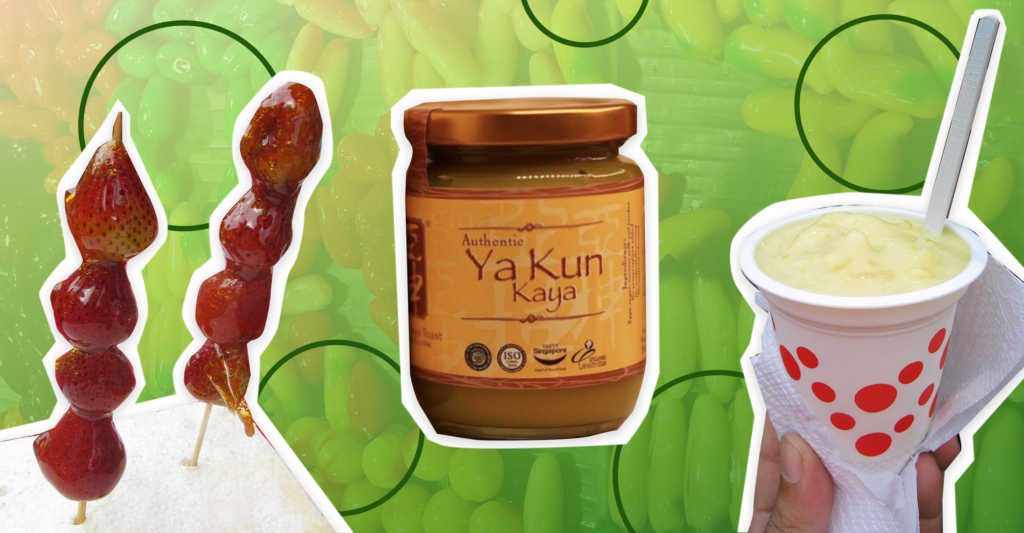Welcome to EnVi Eatery! There are classic flavors like chocolate, vanilla, and strawberry, but there are also flavors like mungbean, pandan, and durian that may be more unconventional to the taste palate. With this edition of EnVi Eatery, let’s delve into the deeper stories of Asian culture beyond desserts and explore the ingredients behind the ultimate compliment: “not too sweet.”
Pandan – Kaya Toast
Often described to taste like a mixture of coconut and vanilla, pandan is a plant abundant in Southeast Asia. Its cheap price and versatile textures (e.g. paste, powder, extract) makes it a popular and accessible flavor that defines Southeast Asian desserts with a unique green tint.
The most famous pandan dish is Kaya toast, a traditional breakfast meal in Singapore. The key ingredient, Kaya jam, is a paste made of pandan, coconut, and egg; the rich jam is slathered on burnt toast with a block of butter and served alongside kopi (coffee) and boiled eggs, making it the perfect start to a crisp Singaporean morning or afternoon tea. The dish is believed to be an adaptation of British fruit jams. During colonial times, Hainanese cooks who worked on British ships settled in Singapore, eventually adding a green twist to the jam spread.
Mungbean – Luk Chup
Mungbeans, a seemingly insignificant and unlikely-to-be-sweet bean, make up a major flavor in Asian desserts. Commonly cultivated in areas of Asia, they are often mashed into a creamy paste to infuse snacks with the ultimate “sweet, but not too sweet” profile.
One dish that balances taste with aesthetics is the signature Thai street food Luk Chup. The dish was derived from marzipan when the people of Thailand replaced almond with the more commonly found mungbean. Molded by hand and painted with vibrancy, the finishing touch of agar gives Luk Chup a juicy, glass-like hue. The artistry it takes to make this dessert initially limited it to the royal family, but now, the delicacy sits comfortably in woven baskets in unassuming corners of street markets.
Hawthorne – Tanghulu
Characterized as ruby spheres of sweet and sour, hawthorns are one of the stronger flavors in this list. Hawthorn trees are relatively easy to grow, making hawthorns an easy ingredient for snacks in northern China.
The most notable hawthorne snack is tanghulu, a fruit skewer dipped into boiling brown sugar that hardens into a sweet shell. Though modern adaptations have made tanghulu more versatile in terms of the fruits offered, the classic interpretation has always used hawthornes.
Just like Luk Chup, tanghulu has a royal past with the Chinese imperial family, but with a medicinal twist. When one of the emperor’s concubines fell sick, the tanghulu recipe was proposed to her as a cure. Word spread about this simple recipe with supposed medicinal properties, and it soon became a hit in street markets thanks to its addictive crisp and crunch.
Durian – Es Durian
Nicknamed the “king of fruits,” but also banned from public transportation, the durian announces its spiky appearance miles away with its (in)famous scent. Another tropical fruit that grows in tropical Southeast Asia, durians are unlike any fruit on this list — they require much care and expertise to develop into their optimal form.
One durian dessert is the Indonesian street food Es durian, a durian ice cream made with a mix of durian pulp, coconut milk, and shaved ice. It’s a perfect composition, juxtaposing the thick creaminess of the durian fruit with thin slices of ice that mask the durian’s scent without taking away the fruit’s rich taste. Es durian is a more beginner-friendly approach to this unpopular, yet essential, Southeast Asian fruit.
Taro – Taro Balls
Another low maintenance plant is taro, which is common to most Asian regions as one of the earliest cultivated crops. Taro is healthy, creamy, and leaves the perfect mellow lavender hue for an aesthetic Instagram story post.
With flexibility in texture, taste, and shape, taro has claimed a special status in Taiwan’s famed night markets among a plethora of desserts. One of its most commonly-iterated forms is the taro ball, or yù yuán. Its chewy and starchy texture is concocted with a mixture of mashed taro, sweet potato flour, and water, adding a magical crystal hue to the outer layer of each ball. Though you can eat them alone, taro balls are usually found alongside red beans, shaved ice, and sweet syrup. A place to enjoy taro balls is Meet Fresh, a large dessert chain found throughout Asia, North America, and Europe.
Want to cook up some Filipino comfort foods for the chilly weather? Try out five of our favorite recipes here!




